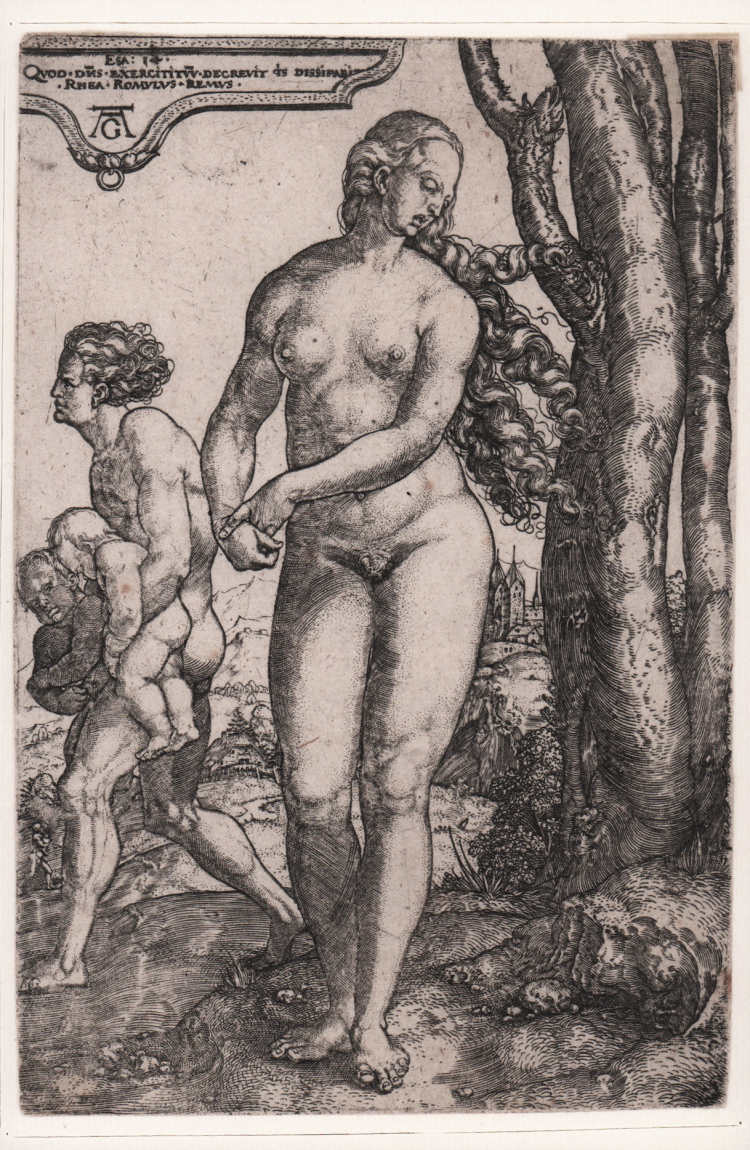



| Reference: | S44840 |
| Author | Heinrich ALDEGREVER |
| Year: | 1532 |
| Measures: | 97 x 145 mm |


| Reference: | S44840 |
| Author | Heinrich ALDEGREVER |
| Year: | 1532 |
| Measures: | 97 x 145 mm |
Rhea Silvia; whole-length nude figure in frontal view, standing in a landscape; her head turned to right, away from Amulius carrying off Romulus and Remus to left.
Engraving, 1532, signed with monogram and lettered with three lines of Latin in a cartouche at upper left: ESA: 14/ QUOD. D[omi]N[u])S. / EXERCITITVV[m] DECR/E VIT. q's. (quis) DISSIPABIT./ RHEA. ROMVLUS, REMVS." [Isaiah XIV, 27: Dominum enim exercituum decrevit: et quis poterit infirmare? (Who shall annul the Lord's decree, who shall thwart it? Rhea. Romulus. Remus].
According to Hollstein the figure of Rhea Silvia inspired by Leonardo da Vinci's 'Leda' and Marcantonio Raimondi's 'Dido' (Bartsch 187).
The theme tells of Rhea Silvia, the mother of the twins Romulus and Remus, and the legend associated with the founders of Rome. Her events are told to us in the 1st book Ab urbe condita by Titus Livius, in fragments from the Annales of Ennius and by Fabius Painter. According to one version, the god Mars fell in love with the girl and seduced her in a forest; Livy instead reports that Rhea Silvia was raped, and that to make the deed less turpent, he declared the god responsible. According to Livy's account, Rhea Silvia was the daughter of Numitore, a descendant of Aeneas and King of Alba Longa. Numitore's younger brother, Amulius, usurped the throne and, killed his brother's male children, and forced Rhea Silvia to become a priestess of the Goddess Vesta, to prevent her from having an offspring, since vestal women were required to be chaste for 30 years. When her uncle learned of the birth of Rhea's twins, he had her arrested and ordered a servant girl to kill Romulus and Remus. The servant, however, took pity on them, put them in a basket and entrusted them to the waters of the Tiber. The basket, miraculously, sailed calmly down the river and stranded at the place where the twins would later found Rome.
Shortly before 1520, some young artists in Albercht Dürer's circle took to making very small engravings that challenged the viewer with a miniature world of new secular subject matter and unconventional interpretations of traditional themes. Because of the small size of their engravings, these artists have long been affixed with the collective, and unflattering, name of Small Nuremberg Masters. The core of the group consists of three artists from Nuremberg, Hans Sebald & Bartel Beham and Georg Pencz, and in addition Jacob Bink from Cologne and Heinrich Aldegrever from Soest.
A fine impression, printed on contemporary laid paper, trimmed to the platemark, in good conditions.
Bibliografia
New Hollstein (German), The New Hollstein: German engravings, etchings and woodcuts 1400-1700 (66); Bartsch; Le Peintre graveur (VIII.386.66).
Heinrich ALDEGREVER (Paderborn, 1502; Soest, Westfalia, 1555–61)
|
German engraver, painter and designer. He was the most important graphic artist in Westphalia in the 16th century. His reputation rests largely on his ornamental designs, which make up about one third of his c. 300 engravings. They were principally intended as models for metalworkers but were also adapted by other craftsmen for such decorative arts as enamel, intarsia and book illustration. Aldegrever followed Dürer and the Nuremberg LITTLE MASTERS, deriving models for his paintings and subject prints as well as a full repertory of Renaissance ornamental motifs: fig and acanthus foliage, vases and cornucopia, combined with putti and satyrs, tritons, mermaids and dolphins, sphinxes, masks and medallions. From the beginning of his career Aldegrever was aware of the artistic trends of the time: the Dürer influence was strongest at its outset yielding somewhat in work of the 1530s to Mannerist tendencies under Netherlandish influence, though never waning entirely.
|
Heinrich ALDEGREVER (Paderborn, 1502; Soest, Westfalia, 1555–61)
|
German engraver, painter and designer. He was the most important graphic artist in Westphalia in the 16th century. His reputation rests largely on his ornamental designs, which make up about one third of his c. 300 engravings. They were principally intended as models for metalworkers but were also adapted by other craftsmen for such decorative arts as enamel, intarsia and book illustration. Aldegrever followed Dürer and the Nuremberg LITTLE MASTERS, deriving models for his paintings and subject prints as well as a full repertory of Renaissance ornamental motifs: fig and acanthus foliage, vases and cornucopia, combined with putti and satyrs, tritons, mermaids and dolphins, sphinxes, masks and medallions. From the beginning of his career Aldegrever was aware of the artistic trends of the time: the Dürer influence was strongest at its outset yielding somewhat in work of the 1530s to Mannerist tendencies under Netherlandish influence, though never waning entirely.
|